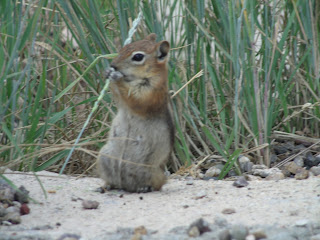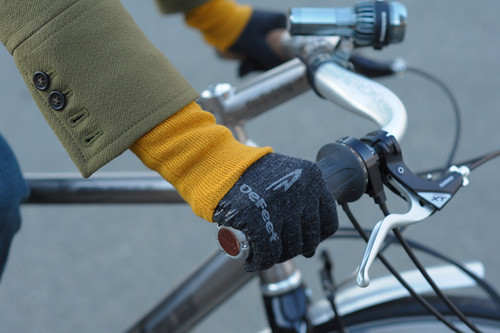
Even once I had the rest of my winter attirefigured out, the article of clothing that gave me the most trouble was gloves. I've probably gone through half a dozen pairs since I began cycling, and nothing worked quite the way I wanted it to. The big puffy gloves made it difficult to move my fingers and interferedwith shifting and braking, even if the design was supposedly cycling-specific. Also, I do photography work outdoors in the winter, and operating a camera with those is out of the question. Thermally-lined leather gloves can be just as warm while allowing for more mobility, but the leather gets stretched out and worn when used repeatedly on a bike. Wool gloves are hit and miss as far as warmth and some can be quite slippery on the handlebars. My salvation finally came in the form of these charcoal gray wool gloves by
DeFeet which I bought on a whim at a local bike shop. They may not look like much, but I love them.
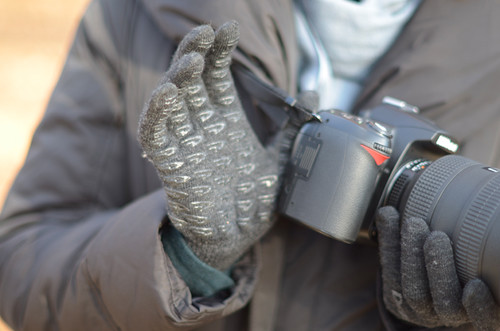
The
DeFeet Duraglove is very densely knit, and warmer than any other thin wool gloves I've worn thus far. Once the temperature drops into the low 20s and I spend more than an hour outside I do begin to feel a chill in the finger tips, but above that they keep my hands perfectly warm (for comparison, I have a pair of stretchy-fleecy cross-country ski gloves rated for 20s temps that in reality give out in the low 30s). Aside from the warmth, the DeFeet gloves are form-fitting and stretchy, making it easy to operate both city bike and roadbike levers. And I can press all of my camera controls without removing them. They are not beautiful, but not horrendous looking either. They cost under $20. And the underside is covered with these silicone grippy things that ensure a firm hold on handlebars and camera equipment.

The Co-Habitant is also pleased with his
Ibex Knitty Gritty gloves that are similarly designed. He has a pair of both the full fingered and the fingerless versions and he uses both, depending on the temperature, for cycling and photography. The wool on these is softer and a bit chunkier than the wool of the
DeFeet gloves, but the idea is the same: stretchy wool for ease of movement, with silicone grips on the underside for a firm hold. The grippy bits here are in the form of little
Ibex logos, which I find very cute.
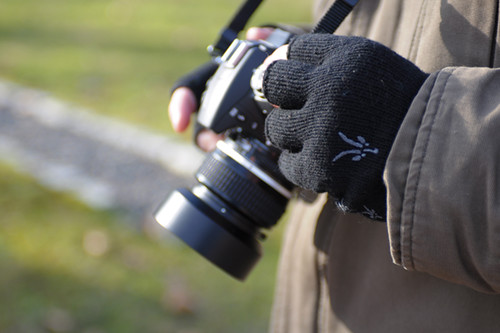
Unfortunately the
Ibex Knitty-Gritty gloves do not work for me, because even the smallest size is too big for my hands (beware, these run large), so I cannot compare them to my
DeFeetgloves directly.The prices are about the same. To my eye the
Ibexgloves are more attractive, but of course this says nothing about performance. The cuff on the
Ibex is a tad longer, but on both gloves the length is sufficient.The softer
Ibex wool is nice, but I am suspicious that the looser knit might translate into less warmth. Also, I have noticed a bit of pilling on the Co-Habitant's full-fingered gloves after a season's use, whereas the wool on my
DeFeet gloves seems less prone to this.

Sadly, I did experience wear and tear with my
DeFeet gloves: After 300+ miles of use on the bike, I wore a hole in the tip of the right index finger. While this is apparently a common problem to have with wool gloves, in my case I have to underscore that (1) I'd been wearing these on a roadbike and constantly pressing the ergo lever with my right hand, and (2) I have long fingernails, which no doubt contributed to this. Had I used them solely for transportation cycling on an upright bike, they probably would have been fine. In any case, I've now mended the hole (there is a special way to do this without destroying the articulated fingertip) and will see how long that lasts. If need be, I am willing to keep mending them and to buy a new pair every now and again, because as far as functionality and warmth go these gloves really work for me. I love the dense stretchy wool and the grippy underside; the versatility this style affords has made it my favourite winter cycling glove thus far.








 Even once I had the rest of my winter attirefigured out, the article of clothing that gave me the most trouble was gloves. I've probably gone through half a dozen pairs since I began cycling, and nothing worked quite the way I wanted it to. The big puffy gloves made it difficult to move my fingers and interferedwith shifting and braking, even if the design was supposedly cycling-specific. Also, I do photography work outdoors in the winter, and operating a camera with those is out of the question. Thermally-lined leather gloves can be just as warm while allowing for more mobility, but the leather gets stretched out and worn when used repeatedly on a bike. Wool gloves are hit and miss as far as warmth and some can be quite slippery on the handlebars. My salvation finally came in the form of these charcoal gray wool gloves by DeFeet which I bought on a whim at a local bike shop. They may not look like much, but I love them.
Even once I had the rest of my winter attirefigured out, the article of clothing that gave me the most trouble was gloves. I've probably gone through half a dozen pairs since I began cycling, and nothing worked quite the way I wanted it to. The big puffy gloves made it difficult to move my fingers and interferedwith shifting and braking, even if the design was supposedly cycling-specific. Also, I do photography work outdoors in the winter, and operating a camera with those is out of the question. Thermally-lined leather gloves can be just as warm while allowing for more mobility, but the leather gets stretched out and worn when used repeatedly on a bike. Wool gloves are hit and miss as far as warmth and some can be quite slippery on the handlebars. My salvation finally came in the form of these charcoal gray wool gloves by DeFeet which I bought on a whim at a local bike shop. They may not look like much, but I love them. The DeFeet Duraglove is very densely knit, and warmer than any other thin wool gloves I've worn thus far. Once the temperature drops into the low 20s and I spend more than an hour outside I do begin to feel a chill in the finger tips, but above that they keep my hands perfectly warm (for comparison, I have a pair of stretchy-fleecy cross-country ski gloves rated for 20s temps that in reality give out in the low 30s). Aside from the warmth, the DeFeet gloves are form-fitting and stretchy, making it easy to operate both city bike and roadbike levers. And I can press all of my camera controls without removing them. They are not beautiful, but not horrendous looking either. They cost under $20. And the underside is covered with these silicone grippy things that ensure a firm hold on handlebars and camera equipment.
The DeFeet Duraglove is very densely knit, and warmer than any other thin wool gloves I've worn thus far. Once the temperature drops into the low 20s and I spend more than an hour outside I do begin to feel a chill in the finger tips, but above that they keep my hands perfectly warm (for comparison, I have a pair of stretchy-fleecy cross-country ski gloves rated for 20s temps that in reality give out in the low 30s). Aside from the warmth, the DeFeet gloves are form-fitting and stretchy, making it easy to operate both city bike and roadbike levers. And I can press all of my camera controls without removing them. They are not beautiful, but not horrendous looking either. They cost under $20. And the underside is covered with these silicone grippy things that ensure a firm hold on handlebars and camera equipment. The Co-Habitant is also pleased with his Ibex Knitty Gritty gloves that are similarly designed. He has a pair of both the full fingered and the fingerless versions and he uses both, depending on the temperature, for cycling and photography. The wool on these is softer and a bit chunkier than the wool of the DeFeet gloves, but the idea is the same: stretchy wool for ease of movement, with silicone grips on the underside for a firm hold. The grippy bits here are in the form of little Ibex logos, which I find very cute.
The Co-Habitant is also pleased with his Ibex Knitty Gritty gloves that are similarly designed. He has a pair of both the full fingered and the fingerless versions and he uses both, depending on the temperature, for cycling and photography. The wool on these is softer and a bit chunkier than the wool of the DeFeet gloves, but the idea is the same: stretchy wool for ease of movement, with silicone grips on the underside for a firm hold. The grippy bits here are in the form of little Ibex logos, which I find very cute. Unfortunately the Ibex Knitty-Gritty gloves do not work for me, because even the smallest size is too big for my hands (beware, these run large), so I cannot compare them to myDeFeetgloves directly.The prices are about the same. To my eye the Ibexgloves are more attractive, but of course this says nothing about performance. The cuff on the Ibex is a tad longer, but on both gloves the length is sufficient.The softer Ibex wool is nice, but I am suspicious that the looser knit might translate into less warmth. Also, I have noticed a bit of pilling on the Co-Habitant's full-fingered gloves after a season's use, whereas the wool on my DeFeet gloves seems less prone to this.
Unfortunately the Ibex Knitty-Gritty gloves do not work for me, because even the smallest size is too big for my hands (beware, these run large), so I cannot compare them to myDeFeetgloves directly.The prices are about the same. To my eye the Ibexgloves are more attractive, but of course this says nothing about performance. The cuff on the Ibex is a tad longer, but on both gloves the length is sufficient.The softer Ibex wool is nice, but I am suspicious that the looser knit might translate into less warmth. Also, I have noticed a bit of pilling on the Co-Habitant's full-fingered gloves after a season's use, whereas the wool on my DeFeet gloves seems less prone to this. Sadly, I did experience wear and tear with my DeFeet gloves: After 300+ miles of use on the bike, I wore a hole in the tip of the right index finger. While this is apparently a common problem to have with wool gloves, in my case I have to underscore that (1) I'd been wearing these on a roadbike and constantly pressing the ergo lever with my right hand, and (2) I have long fingernails, which no doubt contributed to this. Had I used them solely for transportation cycling on an upright bike, they probably would have been fine. In any case, I've now mended the hole (there is a special way to do this without destroying the articulated fingertip) and will see how long that lasts. If need be, I am willing to keep mending them and to buy a new pair every now and again, because as far as functionality and warmth go these gloves really work for me. I love the dense stretchy wool and the grippy underside; the versatility this style affords has made it my favourite winter cycling glove thus far.
Sadly, I did experience wear and tear with my DeFeet gloves: After 300+ miles of use on the bike, I wore a hole in the tip of the right index finger. While this is apparently a common problem to have with wool gloves, in my case I have to underscore that (1) I'd been wearing these on a roadbike and constantly pressing the ergo lever with my right hand, and (2) I have long fingernails, which no doubt contributed to this. Had I used them solely for transportation cycling on an upright bike, they probably would have been fine. In any case, I've now mended the hole (there is a special way to do this without destroying the articulated fingertip) and will see how long that lasts. If need be, I am willing to keep mending them and to buy a new pair every now and again, because as far as functionality and warmth go these gloves really work for me. I love the dense stretchy wool and the grippy underside; the versatility this style affords has made it my favourite winter cycling glove thus far.

 In the comments section of a post from a couple of days ago, I made a remark suggesting that bike shops have financial incentive to sell bikes and accessories separately, as opposed to bikes that do not need additional accessories. I have since received emails asking to expand on that, so let me give it a try.
In the comments section of a post from a couple of days ago, I made a remark suggesting that bike shops have financial incentive to sell bikes and accessories separately, as opposed to bikes that do not need additional accessories. I have since received emails asking to expand on that, so let me give it a try.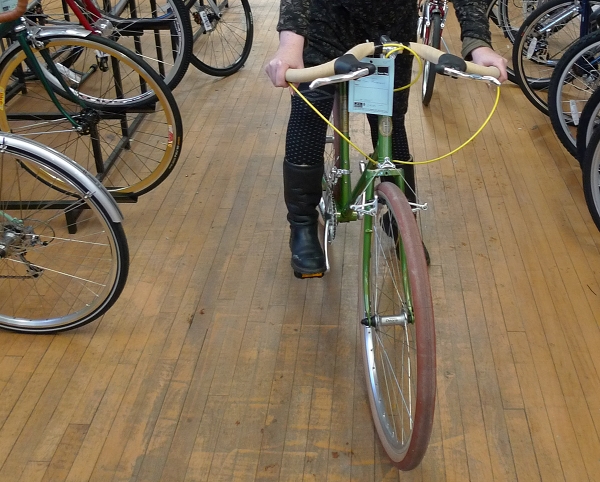 Consider first, that the retail mark-up on bicycles is usually less, percentage-wise, than the retail mark-up on components and accessories. The better made the bicycle, the more this is so, as production costs for that bike are high and there is a ceiling to what most customers are willing to pay.
Consider first, that the retail mark-up on bicycles is usually less, percentage-wise, than the retail mark-up on components and accessories. The better made the bicycle, the more this is so, as production costs for that bike are high and there is a ceiling to what most customers are willing to pay. So, what incentive is there for bike shops to stock high quality, complete city bicycles and to be motivated to sell them to customers in leu of maximising profits by selling bikes and accessories separately? The way I see it, it is about short-term versus long-term profits - In other words, about building enduring relationships with customers. By acting in a customer's best interest - both in terms of the kind of bicycles they choose to stock in the first place, and in terms of the purchasing suggestions they make to those who walk in off the street - the bike shop is sacrificing immediate profits for the benefits of repeat business and word of mouth advertisement that could result from this customer.
So, what incentive is there for bike shops to stock high quality, complete city bicycles and to be motivated to sell them to customers in leu of maximising profits by selling bikes and accessories separately? The way I see it, it is about short-term versus long-term profits - In other words, about building enduring relationships with customers. By acting in a customer's best interest - both in terms of the kind of bicycles they choose to stock in the first place, and in terms of the purchasing suggestions they make to those who walk in off the street - the bike shop is sacrificing immediate profits for the benefits of repeat business and word of mouth advertisement that could result from this customer.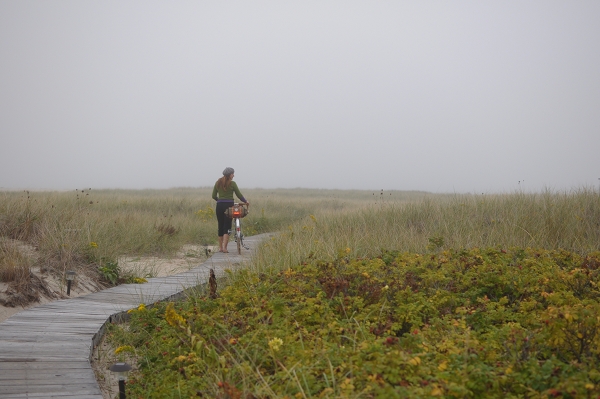 Have you ever cycled in a dense fog?
Have you ever cycled in a dense fog? For the past couple of days, we have been surrounded by this stunning, surreal landscape. There is no distinction between sky and ocean. The dunes, grasses and rosehip bushes are wrapped in a milky whiteness. There is a tornado warning in effect, but for now everything is eerily calm.
For the past couple of days, we have been surrounded by this stunning, surreal landscape. There is no distinction between sky and ocean. The dunes, grasses and rosehip bushes are wrapped in a milky whiteness. There is a tornado warning in effect, but for now everything is eerily calm.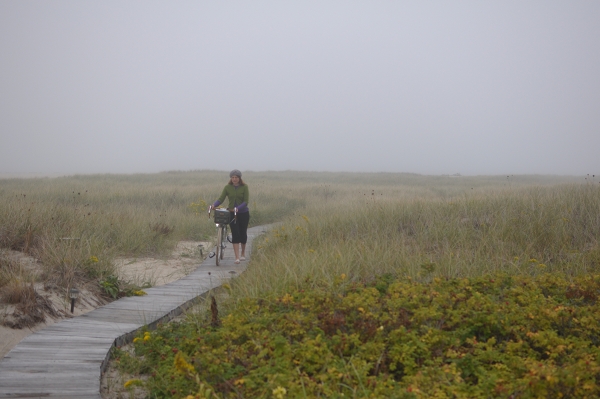 To watch someone approaching through the fog from a distance has always fascinated me. It looks as if the person is coming from nowhere, or from the sky.
To watch someone approaching through the fog from a distance has always fascinated me. It looks as if the person is coming from nowhere, or from the sky. I took the opportunity to see how Graham's lights would perform in these conditions, and they were fairly well visible - even at slow speeds.
I took the opportunity to see how Graham's lights would perform in these conditions, and they were fairly well visible - even at slow speeds.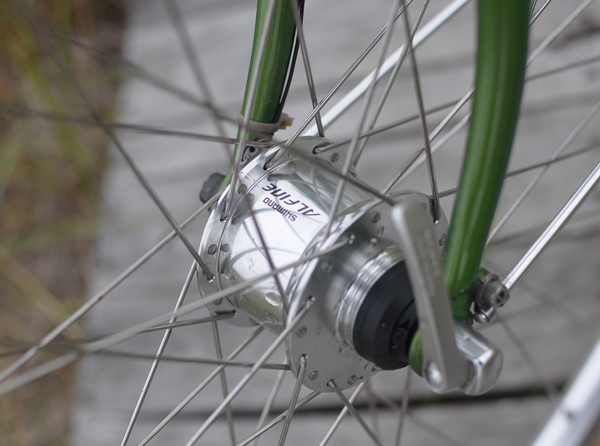 The lights on my Rivendell Sam Hillborne are powered by a Shimano Alfine hub.
The lights on my Rivendell Sam Hillborne are powered by a Shimano Alfine hub. The headlight is aBusch & MüllerLumotec IQ LED Cyo Senso Plus, and its performance is stunning.The beam is not just powerful, but surprisingly large -so that cycling in the dark feels as if there is always a street light on. There is a standlight feature (the light remains on for a few minutes after the bicycle stops), as well as a "senso" feature, whereby the light turns itself on and off depending on how dark it is.
The headlight is aBusch & MüllerLumotec IQ LED Cyo Senso Plus, and its performance is stunning.The beam is not just powerful, but surprisingly large -so that cycling in the dark feels as if there is always a street light on. There is a standlight feature (the light remains on for a few minutes after the bicycle stops), as well as a "senso" feature, whereby the light turns itself on and off depending on how dark it is. The tail light is aBusch & Müller 4D-lite Plus, which has classic looks, 4 LEDs, and the same standlight feature as the headlight (though the Co-Habitant thinks the standlight on this one is not sufficiently bright).
The tail light is aBusch & Müller 4D-lite Plus, which has classic looks, 4 LEDs, and the same standlight feature as the headlight (though the Co-Habitant thinks the standlight on this one is not sufficiently bright).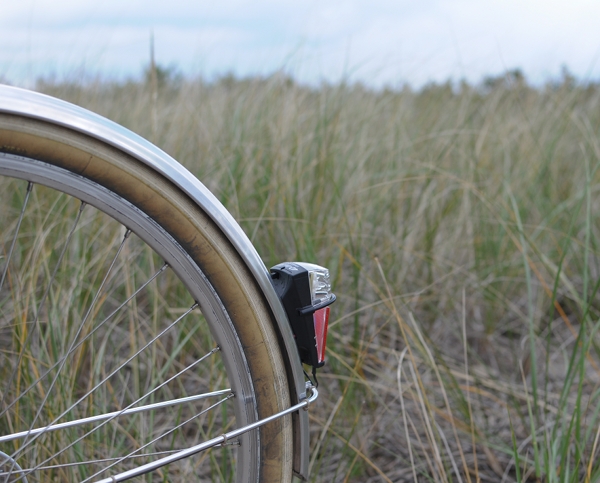 An additional feature of this tail light is that it is surrounded by a metal cage, which prevents the light from being damaged when it is bumped. This is very useful when the bicycle is dragged through doors and left at bike racks.
An additional feature of this tail light is that it is surrounded by a metal cage, which prevents the light from being damaged when it is bumped. This is very useful when the bicycle is dragged through doors and left at bike racks. I am confident that others can see me in the fog with the light set-up I have on this bicycle. Seeing the road, however, is another matter. What do randonneurs do in these situations? I cannot imagine that any bicycle light can really be strong enough to act as a true fog light in the daytime.
I am confident that others can see me in the fog with the light set-up I have on this bicycle. Seeing the road, however, is another matter. What do randonneurs do in these situations? I cannot imagine that any bicycle light can really be strong enough to act as a true fog light in the daytime.

